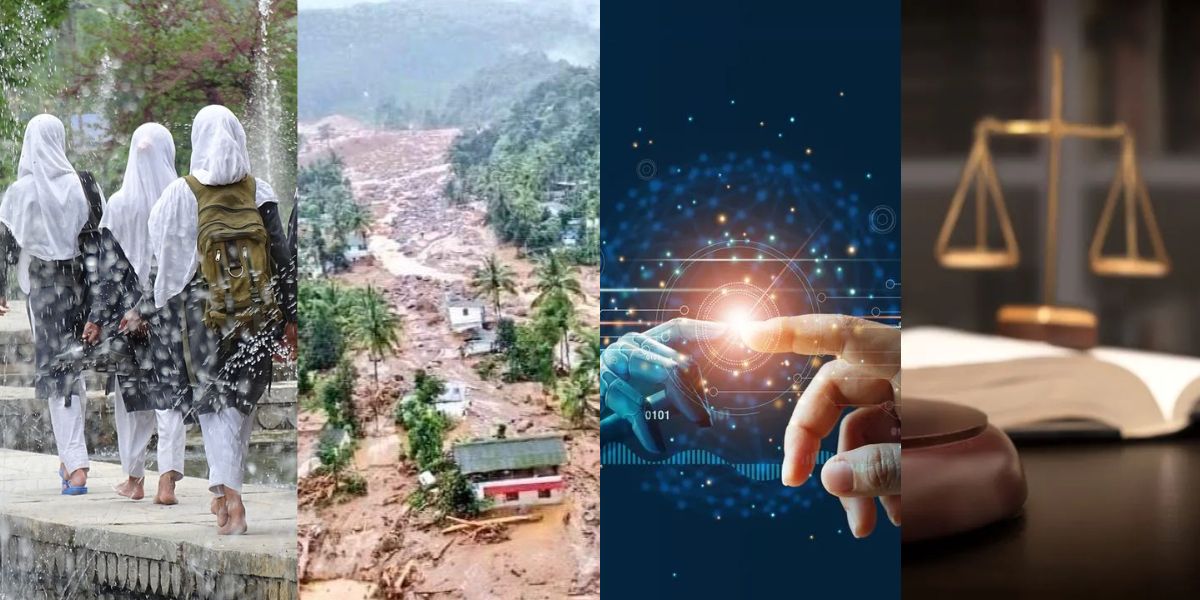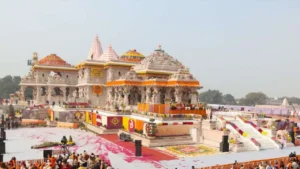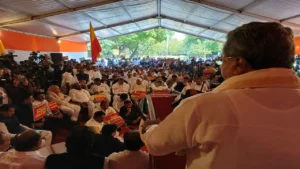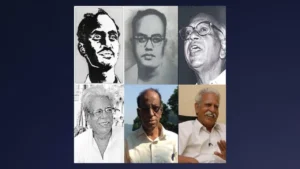The year 2024, too, saw its share of ups and downs, controversies, and debates. As the millennium turns 25, South First takes a quick look at the talking points that grabbed wide attention during the past 12 months.
Published Dec 31, 2024 | 6:00 PM ⚊ Updated Dec 31, 2024 | 6:00 PM

The winter session of Parliament in 2023 witnessed the government overhauling the criminal justice system, even as 141 Opposition members were suspended. A year later in December, the government introduced the ‘One Nation, One Election’ Bills, despite strong opposition. In between, the country witnessed several controversies, most of them having a bearing on the general public, the citizens of the world’s largest democracy. Even as the millennium turns 25, and the world prepares to welcome the era of Generation Beta, South First recaps the issues widely discussed during the past 12 months.
In its 2023 Winter Session, with over 141 of its Opposition members suspended, Parliament set in motion a complete overhaul of the Indian criminal justice system through the passage of three contested statutes, the Bharatiya Nyaya Sanhita, 2023 (BNS), the Bharatiya Nagarik Suraksha Sanhita, 2023 (BNSS) and the Bharatiya Sakshya Adhiniyam, 2023 (BSA). This overhaul was underlined with undemocratic processes and grave procedural impropriety.
After an ambushed introduction in the 2023 Monsoon Session through the ‘supplementary’ list of business, the Bills were referred to the Parliamentary Standing Committee on Home Affairs (PSC) once the shock subsided.
The PSC, however, fell remarkably short of the legitimate expectation. The review process was riddled with sealed-envelope discussions and missed opportunities, undermining its importance.
The new laws, though aimed at “decolonising” the legal system, manage to retain and even regress some antiquated concepts from the earlier Codes.
A befitting example is the sedition law. The constitutionality of Section 124-A IPC has been under the scanner for a while now because the law is a remnant of colonial times and cannot be retained in a democratic republic.
“The Constitution does not make a distinction between the faith and belief of one religion and another. All forms of belief, worship and prayer are equal,” the Supreme Court said in its Babri Masjid-Ram Janmabhoomi Ayodhya title dispute case verdict in 2019.

Ram Temple in Ayodhya. (Creative Commons)
The judgement repeatedly referred to Muslims being wronged by the desecration and eventual demolition of Babri Masjid, the Constitutional mandate of equality of all faiths, and the need to remedy the wrong.
However, the nationwide spectacle over the Ayodhya Ram Temple consecration ceremony became an act of majoritarian Hindu assertion in a secular country.
The chant of god is powerful. It determines life and death, depending on how fiercely one believes in the chant.
On 22 January, 2024, millions of Hindus will chant the name of their God, Ram, as his idol is consecrated in a brand new temple in Ayodhya.
Twenty-five years ago, on 22 January, 1999, a Hindutva vigilante mob chanted the name of another god, Hanuman — who features closely in Ram’s life — as they intentionally burnt an Australian Christian preacher, Graham Staines, and his two minor sons, to death in the remote Odisha village of Manoharpur.
How weird that one was celebrated — another will be celebrated — as a majoritarian religious victory over evil represented by a minority religion.
Several key questions about our secular democracy arise as India elects its 18th Lok Sabha in general elections shortly.
The Constitution speaks of justice and equality for all citizens, but we have witnessed an unprecedented trend of majoritarianism in the last few years. Religious polarization and hate threaten the fabric of our multi-cultural, multi-faith society.
Muslims, the largest minority, comprise nearly 15 percent of our population as per the census of 2011. Their political representation is at an all-time low, with just 27 MPs (in the 17th Lok Sabha). The BJP does not put up Muslim candidates as a rule, and Congress and other so-called secular parties are increasingly seen to be weary of fielding Muslims.
They are communally discriminated against and live with poor civic amenities in ghettoes across cities and towns. Today, they face a tremendous onslaught of hate and near-total political exclusion.
When the pandemic forced our economy to shut down, one particular sector in India experienced significant growth. It transformed into a prosperous business venture. The EdTech industry flourished as physical interactions were gradually replaced by hybrid and online platforms.

Byju’s logo.
Today, over 5,500 recognised start-ups are in this sector, as acknowledged by the Department of Promotion of Industry and Internal Trade (DPIIT). A report by Redseer Consulting reveals that Indian EdTech start-ups generated revenues worth $2.2 billion in 2020 alone. These companies have consistently targeted the affluent private school market to establish partnerships with coaching institutes.
Byju’s, founded in 2011 by Byju Raveendran and Divya Gokulnath, transformed the landscape of online education. Initially focusing on offline coaching sessions, the company later introduced an app featuring video lectures and interactive tests. As the app gained popularity among students and parents, it attracted significant investments. Extensive advertising campaigns further boosted its reach.
However, Byju’s faced financial challenges, failing to repay a $300 million loan from Redwood Global Investments in 2021 and violating the terms of a $500 million loan in 2022.
At its peak, Byju’s employed more than 58,000 individuals in 2022. However, by May 2023, this number had decreased significantly to 24,000 due to massive layoffs that sparked protests among the workforce. The company’s funding also drastically increased from a modest $4.6 million in 2013 to a staggering $1.7 billion in 2020.
Alleging fiscal injustice, South Indian states are demanding an equitable share of resources from the Union government. With Karnataka, Tamil Nadu, Kerala, and Andhra Pradesh raising the chorus for the South Tax Movement, the demand to preserve fiscal federalism is growing stronger.

Karnataka CM Siddaramaiah addressing the protest against the Union government at Jantar Mantar, Delhi. (Supplied)
There is a glaring gap between the southern states’ contribution, and how much they receive in comparison with the top five receiving states — three of which are in the Hindi heartland.
Among the leading five recipients, Maharashtra is the only state contributing a significant share of GST, Cess, and direct taxes to the Center. Uttar Pradesh, Bihar, and Madhya Pradesh form the Hindi heartland, a region that consistently influences electoral outcomes.
None of the southern states figures among the top seven recipients. Tamil Nadu receives the eighth highest share — 4.07 percent — from the central pool of taxes.
In March, India became the newest country in line to tame the AI revolution unleashed on the world. MeitY has declared that AI models or programs lacking thorough testing or reliability in India must only be accessible on the Internet if they receive government approval.
This has been met with criticism from AI experts, who say this step goes too far and will only slow down AI innovation in the country and leave it lagging behind its global peers.
While this might be true, it is also undisputable that this new technology has left many governments unaware and left policymakers in the unenviable position of racing to formulate policies around a technology that is still rapidly evolving. Very few people in the world truly understand.
So, with this in mind, for today, let’s instead focus on the different ways AI is being regulated around the world.
Before and after Partition, more than 700 men from North Kerala travelled to Lahore and Karachi in Pakistan for employment. They didn’t perceive many differences between Karachi and Mumbai then; they sought a better way to support their large joint families back home.
After returning home years later, primarily located along the Malabar Coast in northern Kerala, these individuals were uncertain about their future as they did not belong to India or Pakistan.
Now, as the citizenship issue is creating a large-scale sensation in India, Kerala police remain clueless about the number of surviving ‘Pakistani nationals’ in Malappuram.
The last available list of ‘Pakistani nationals’ in Malappuram, kept at the district police office, contains the names, addresses, ages, and contact numbers of 87 persons.
If women’s unpaid work is calculated, it will account for 7.5 percent of India’s GDP, claims SBI’s Ecowrap report. Other surveys claim it is 39 percent of the GDP.
That is roughly around ₹22.7 crore of unpaid work done annually by women in India — just a little less than the construction sector.
Tertiary (services) sector employees contribute 54 percent to the GDP. Still, women — 51 percent of the country’s population — have no value for their work in their homes. This work is unpaid and undervalued.
Women do not have a choice but to labour and undertake care jobs inside the house. Like poverty, unpaid work is feminised and invisibilised.
Dr BR Ambedkar, the architect-in-chief of the Constitution, was one of the most radical egalitarians of the 20th century.
The concept of equality was so close to his heart and soul that, on the evening of his life, he conceived a multi-volume history of (in)equality in India under the title, Revolution and Counter-Revolution in Ancient India.
He ventured to expose Brahmanism as the locomotive of inequality and to demonstrate Buddhism as an egalitarian revolution in ancient India. His major work is Annihilation of Caste (1935), marking him as modern India’s most ‘progressive radical thinker’.
Regarding priesthood in Hinduism, Dr Ambedkar proposed three radical reforms. Fortunately, the Supreme Court and the Madras High Court endorsed Dr Ambedkar’s democratic and egalitarian view on Hindu priesthood.
Ambedkar said it must be open to all, based on individual merit, irrespective of one’s caste. However, the Kerala High Court’s verdict on appointing Melshanthis in Sabarimala Devaswom and Malikappuram Devaswom, the most sacred and lucrative Hindu temples in Kerala.
Three phases may be identified in the tone of campaign rhetoric, as the Lok Sabha election heads into its final phase. All three may be associated with the changing moods of Prime Minister Narendra Modi, as he seeks a third term in office.
In the first phase, there was an appeal to the general good and a projection of Modi’s unique capacity to fulfil this objective.
The subtext was that only people of the Hindu faith mattered, and yet, this was the benign phase.
In the second phase, Modi’s tone was about the disrespect that the opposition combine harboured towards all great achievements under his raj.
This quickly yielded to the third phase of zero-sum calculations, where the progress of any one social class is portrayed as a threat to another.
May 2024 marked the 50th anniversary of the famous or infamous Secunderabad Conspiracy Case (1974-1989), perhaps the first-ever in the then Andhra Pradesh, or even the entire country, implicating writers as accused for their writings and speeches.

From top left: Cherabandaraju (1944-1982), K V Ramana Reddy (1927- 1998), Tripuraneni Madhusudana Rao (1937-2004), M T Khan (1935-2014), M Ranganatham (1948-2020), P Varavara Rao (1940)
The first batch of arrests of the accused, ironically all writers—since the other accused were underground Naxalites who could not be apprehended—took place on 18 May 1974.
The case, known in legal corridors as The State Vs KG Satyamurthy and P Varavara Rao and others, had shown 46 accused, including six writers.
In fact, this was not the first conspiracy case. The Government of Andhra Pradesh had the dubious distinction of manufacturing conspiracy cases even earlier, like the Parvatipuram Conspiracy Case and the Hyderabad Conspiracy case in 1970. Both cases involved revolutionary activists and sympathisers only.
The life of Kannada superstar Darshan is nothing short of a film script.
Coming up in life the hard way, from supplying milk to making a living and being a light boy in film shoots, Darshan had reached a stage only a few could dream of. From being the highest-earning Kannada star whose films rarely bombed at the box office, the “challenging star”, who had several brush-ins with the law over the last 15 years, now faces the biggest challenge yet in his life: arrested for the chilling murder of a fan.
Why did Darshan’s life come to such a pass? One glaring fact was that he failed to handle his success, fame, and popularity. He fell into bad company and, because of his arrogance, created problems for himself.
With its magnificent mountains, deserts, and coastlines, India is a land handcrafted by God.

The degradation of the Himalayas is driven more by local and regional factors rather than global warming. (Jeremy Zero/Wikimedia Commons)
Perhaps, the most vital regions are the Himalayas and the Western Ghats. The snowmelt of the Himalayas provides water to millions of people in the Indo-Gangetic plains while the Western Ghats play with the clouds and provide succour to Peninsular India.
Unfortunately, over the decades, policy-makers have failed to see the need to protect these precious regions that are the catchment areas for rivers that sustain a bulk of the Indian population by providing water for drinking, agriculture, and industries.
What India needs is a catchment area policy to protect these regions.
In today’s fast-paced digital age, technology disruption is often celebrated for its potential to revolutionize industries, streamline operations, and improve quality of life.

The update by CrowdStrike caused a segmentation fault, and led to a “Blue Screen of Death” on Windows boot-up. A scene from LaGuardia Airport, New York City. (Smishra1/Wikimedia Commons)
It is, however, crucial to recognize that technology isn’t infallible. When it fails, the consequences can be severe. It impacts businesses and human lives in profoundly adverse ways.
Countless Windows PCs displayed dreaded “blue screen” errors during the recent Microsoft outage due to CrowdStrike’s bad software upgrade. The outage brought down servers at airlines, locked up computers at banks, and hurt healthcare services. It serves as a stark reminder of the vulnerability of our digital infrastructure.
The event serves as a crucial reminder of what India needs to do to bolster its Digital Public Infrastructure (DPI). India should look at investing in private infrastructure and technology.
Ever since the Justice Hema committee report threw light on the sexual abuse of women in Malayalam cinema, a section of fellow Indians, who love to hate Kerala, have found new reasons. The Malayalam film industry (aka Mollywood) is the new punching bag for the ‘Hate Kerala’ campaigners.
What the haters forget, however, is it is people from the same industry who made the Hema Committee Report possible.
While one can hate ‘Mollywood’ as much as they want, the fact remains that the Malayalam film industry has taken a step that none of its counterparts have taken.
An ostrich-like approach of other film industries in India doesn’t mean they are better. It only means they are afraid to even acknowledge their realities.
The Wakf Bill, 2024, makes provisions to prevent a person from unilaterally declaring his properties as wakf, denying the legitimate rights of the legal heirs.
The Bill makes it mandatory that the person who declares his property as wakf should be a practicing Muslim for at least five years, and that he must own the property being declared as wakf. It also adds that the property being declared as wakf-alal-aulad must not result in the denial of inheritance rights to the donor’s heirs, including female heirs.
A reading of the Bill makes it evident that a blind and politically-motivated rejection of its provisions in toto might be something akin to throwing the baby out along with the bathwater.
More than 300 people were killed in the pre-dawn landslides that hit villages in Chooralmala, Mundakkai, Attamala, and Noolpuzha in the Wayanad district on 30 July. Several houses, shops, tourist resorts, and bridges were destroyed in the nature’s fury.
Scientists have repeatedly warned that the Western Ghats were prone to ecological disasters for years.
An IIT-Delhi report on the soil structure and ecology of this region recommended the relocation of 4,000 people.
The focus must be to prevent disasters and it is for the state governments to use the expertise of scientists and environmentalists and also to take strict steps to ensure that this precious heritage of forest and soil is not destroyed as this is the very basis of human existence.
This is the only way such catastrophes could be prevented during this age of climate change.
Kannadigas, efficient as they have been in bringing Bengaluru to the IT forefront, have become strident in exhibiting their pro-Kannada views, and a few organisations have been set up to defend the state language in no uncertain terms.
Interestingly, there was nothing against Hindi in Bengaluru. Decades ago, it was more against Tamil language and Tamils, largely because of the domination of Tamils in Bengaluru and later, the neighbouring state’s demand for Cauvery, a river which originates in Karnataka.
Why is there so much animosity towards Hindi? It is all about the imposition of the language.
Why is it so tough for women? Because men lack the spine and women, who are at the top, are too busy drowning in the echoes of their own music that they fail to recognise the struggles of another.
The Tamil Nadu government has decided to ban over-the-counter sales of the emergency contraceptive pill containing the hormone levonorgestrel. This pill prevents pregnancy if taken within 72 hours of unprotected sexual intercourse.
A study estimated that 5o percent of all pregnancies in India are unintended and nearly a third end in abortions. In theory, access to abortions in India appears gender-just and fairer than other countries; in practice, access to abortion is complicated and 67 percent of abortions in India are unsafe with the highest risks for those aged 15-19 years and an estimated 8 women die from unsafe abortions daily in the country.
If the contraceptive pill is banned, one obvious outcome is that the incidence of abortions will increase.
Think capital subsidy. Think power pricing. Think land allocation.
State-backed deals have helped the rise of Gautam Adani, the bulk of whose fortunes have been built on regulation-intensive industries such as ports, power plants or airports. And it is apparent that his approach has been to please leaders of all ideological hues and party affiliations.
New India demands a new level of accountability. The US law under which Adani has been indicted shows that the “supply side” of political influence is as important as the demand side in matters of public accountability.
Children are the torchbearers of the future and they will shape and be responsible for the world of work, business, economy, environment, and politics which will affect everybody’s lives.
Many of the children we see today will soon engage in doing things that we do not know and cannot imagine. According to a World Economic Forum (WEF) report, 65% of the children in our primary schools today will be working in jobs that do not yet exist. And the advent of AI is just the beginning for us to get a taste of the future and what lies ahead.
This is the era of “investing in the future” and the state is the most important factor in nurturing and developing its children or ‘human capital’.
However, is it time for another fundamental right — the right to learn — to be introduced? Many studies, particularly in low- and middle-income countries such as India, are showing unambiguously that a large number of our children are attending schools but not learning or gaining basic cognitive and life skills that will help them navigate the world better on their own and take their own decisions.
Vijay presented his party’s ideology, which was actually developed by the DMK from 1949 to 1957. Each sentence of his speech echoed the DMK’s distinction from Dravidar Kazhagam regarding the critical issue of faith
The Telangana government’s ambition of building the “world’s tallest statue” of Mahatma Gandhi at Bapu Ghat near Langer Houz in Hyderabad has drawn mixed reactions.
The idea of honouring the Father of the Nation is a noble one; but when Gandhi himself was averse to power and grand schemes, and preferred to live like the ordinary, poor Indian, is it appropriate for a state government to spend colossal sums of money on his statue?
Some things are highly relevant, not because of what is being said but by whom, in what manner, and in what circumstances.
That must be borne in mind as we look at Priyanka Gandhi Vadra’s debut speech in the Lok Sabha, which also happily coincided with a meaningful debate on the Constitution of India.
However, neither Priyanka Gandhi nor her speech could be construed as the magical solution the Congress has been looking for. The speech showed she is more a silver lining in the cloud for Congress than a silver bullet.
One Nation, One Election: Prelude to one nation, party, religion and leader?
The Union government has decided to forward the One Nation, One Election Bill — officially, the Constitution (129th Amendment) Bill, 2024, and Union Territories (Amendment) Bill, 2024, to a Joint Parliamentary Committee (JPC) for review.
The introduction of the Bills could be seen as the Narendra Modi government further deteriorating the nation’s problems with its authoritarian, anti-democratic policies, pushing India towards becoming an authoritarian fascist state.
Behind parliament scuffles on Ambedkar is the looming battle for Uttar Pradesh
Why is Bhimrao Ramji Ambedkar suddenly so important for India’s national political parties, the BJP and the Congress?
The answer in a broader sense is that the community for which he is the ideological icon, variously called Scheduled Castes or Dalits, constitute about 17 percent of India’s population and spread somewhat evenly over most Indian states.
But Uttar Pradesh, where the shoe pinches for the Bharatiya Janata Party (BJP) led by Prime Minister Narendra Modi, is where the real action is.
